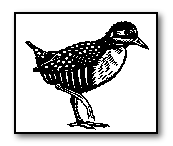|
Glossary of Ecology Terms
San Francisco Bay
Chinook, or king, salmon: One of seven species of salmon in the northern Pacific Ocean. There are four runs, or genetically distinct races, in the Sacramento-San Joaquin river system. Many have been made extinct and most surviving runs are in decline. One of the largest runs, the Sacramento River winter-run Chinook, has been listed as an endangered species.
Delta: The confluence of two rivers – the south-flowing Sacramento and north-flowing San Joaquin – at the upper end of San Francisco Bay. The rivers mingle with smaller Sierra Nevada and Coast Range rivers in 700 miles of channels and sloughs. The Delta has 57 islands and hundreds of thousands of acres of marshes, mudflats and farmland.
Ecosystem: A community of living organisms interacting with one another and with their physical environment, such as a rain forest, pond, or estuary. Damage to any part of a complex system may affect the whole. A system as complex as the Bay/Delta estuary can also be thought of as the sum of many interconnected ecosystems such as the rivers, wetlands, and bays. Ecosystem is a concept applied to communities of different scale, signifying the interrelationships that must be considered.
 Estuary: A partially enclosed, coastal water body where ocean water is diluted by out-flowing fresh water. The San Francisco estuary encompasses the Sacramento and San Joaquin rivers, the Delta and the Suisun, San Pablo, central and south bays.
Estuary: A partially enclosed, coastal water body where ocean water is diluted by out-flowing fresh water. The San Francisco estuary encompasses the Sacramento and San Joaquin rivers, the Delta and the Suisun, San Pablo, central and south bays.
Filter Feeder: An organism that feeds on microscopic food by filtering very large volumes of water. Because of the amount of water filtered, these organisms may tend to concentrate toxins. Filter feeders that live on bottom sediments (e.g., clams and oysters) are particularly susceptible to contamination.
Ground Water: Underground water supplies stored in aquifers. Ground water is supplied by rain which soaks into the ground and flows downward until it collects at a point where the ground is not permeable. Ground water then usually flows laterally toward a river, lake, or the ocean. Wells tap ground water for consumptive uses.
Habitat: The sum of environmental conditions in a specific place that is occupied by an organism, population, or community.
Intertidal Area: The area between high and low tide levels. The alternate wetting and drying of this area makes it a transition between land and water and creates special environmental conditions.
Loading: The total amount of material entering a system from all sources.
Marsh: A wetland where the dominant vegetation is non-woody plants such as grasses and sedges, as opposed to a swamp where the dominant vegetation is woody plants like trees.
Pesticide: A general term used to describe chemical substances that are used to destroy or control pest organisms. Pesticides include herbicides, insecticides, algicides, fungicides, and others. Many of these substances are manufactured and do not occur naturally in the environment. Others, such as pyrethrum, are natural toxins which are extracted from plants and animals.
Salinity Intrusion: The movement of salt water into a body of fresh water. It can occur in either surface water or ground water bodies.
Salinity: The salt content of water, usually expressed as ppt (grams/liter), or ppm (milligrams/liter).
Sediment: Material suspended in or settling to the bottom of a liquid, such as the sand and mud that make up much of the bottom of San Francisco Bay.
Shellfish: An aquatic animal, such as a mollusk (clams and snails) or crustacean (crabs and shrimp), having a shell or shell-like exoskeleton.
Spawning: The deposit of eggs (or roe) by fish and other aquatic life.
Species Diversity: The number of species within a community of organisms. Areas of high diversity are characterized by a great variety of species. A biological community with high diversity is better capable of withstanding environmental disturbances. Pollution tends to reduce biological diversity.
Stormwater: Water that is generated by rainfall and is often routed into drainage systems in order to prevent flooding.
Subtidal: Below the ebb and flow of the tide. Used to refer to the marine environment below mean low tide.
Toxic: Poisonous, carcinogenic, or otherwise directly harmful to life.
Treatment: Chemical, biological, or mechanical procedures applied to an industrial or municipal discharge or to other sources to remove, reduce, or neutralize pollutants.
Turbidity: A measure of the amount of material suspended in the water. Increasing the turbidity of the water decreases the amount of light that penetrates the water column. Sustained, high levels of turbidity are harmful to aquatic life.
Watershed: The geographic region within which water drains into a particular river, stream, or body of water. A watershed includes hills, bottom land, and the body of water into which the land drains. Watershed boundaries are defined by the ridges of separating watersheds. The Bay/Delta estuary’s watersheds include those of the estuary basin and the Central Valley.
Wetland: An area covered permanently, occasionally or periodically with shallow fresh or salt water. Swamps, bogs, marshes and pools absorb flood waters, filter pollutants running off land and provide shelter and feeding grounds for fish and wildlife.
Wetlands: Habitats where the influence of surface- or groundwater has resulted in development of plant or animal communities adapted to aquatic or intermittently wet conditions. Wetlands include tidal flats, shallow subtidal areas, swamps, marshes, wet meadows, bogs, and similar areas.
Sources: Bay in Peril (Examiner, October 1993), p. 4; State of the Estuary Report, Glossary, http://www.abag.ca.gov/bayarea/sfep/reports/soe/table.html

